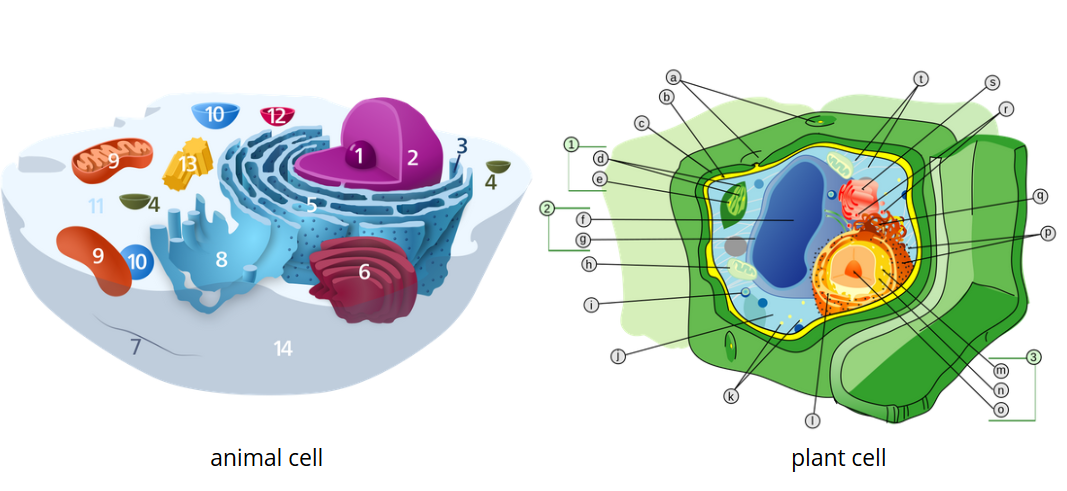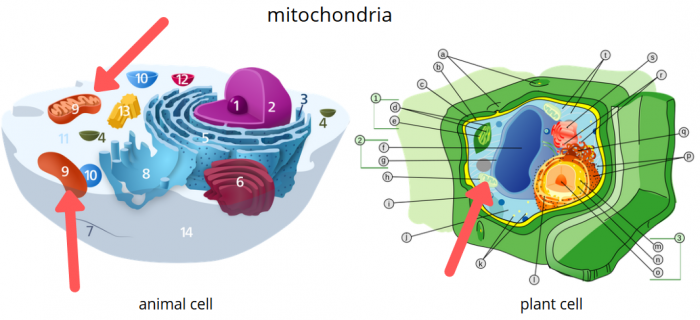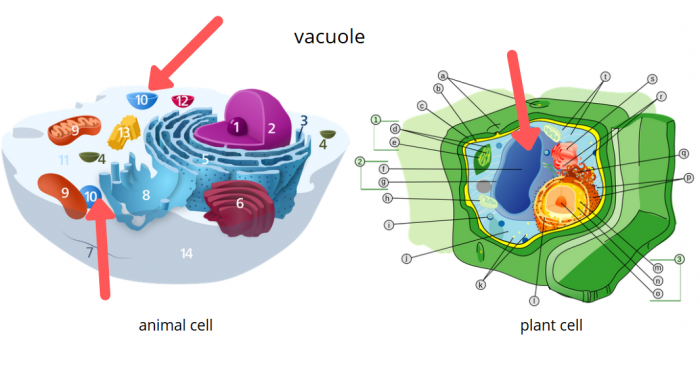
The key difference between plant and animal cells lies in the structural differences. Plant cells are rectangular wheres animal cells are round and plant cells contain chloroplasts, a cell wall, and vacuoles while animal cells do not.
Similarities
Plants and animal cells share many similarities because they are both eukaryotic cells. The similarities between the two have maintained themselves throughout history and the process of evolution because the circumstances each cell type faced were similar and needed similar tools.
“A cell is regarded as the true biological atom.” — George Henry Lewes
Perhaps the most similar part of both cell types is the nucleus, which stores the bulk of the cell’s genome. It is where the DNA is stored and accessed to produce RNA, which are used to produce proteins, and other important cellular products. Many organelles within each cell are membrane-bound.
Among the same organelles that are shared are mitochondria, which is important for power production, endoplasmic reticulum, which is crucial for production of proteins, and lysosomes, which act as waste disposal centers to break down unwanted materials.
Differences
Plant cells are generally larger than animal cells as animal cells can be around 10-30 micrometers while plant cells can range from 10-100 micrometers. Beyond the cell walls, major differences between the two are the existence of chloroplast, vacuoles, and a cell wall within plant cells. These three features each have their own unique functions that create a functional and structural divergence from animal cells.
Plant cells are generally larger than animal cells as animal cells can be around 10-30 micrometers while plant cells can range from 10-100 micrometers. Beyond the cell walls, major differences between the two are the existence of chloroplast, vacuoles, and a cell wall within plant cells. These three features each have their own unique functions that create a functional and structural divergence from animal cells.
| Plant Vs. Animal Cells | Interesting Facts |
| Animal cell Size | 10 to 30 micrometers |
| Cell wall | Plants have a rigid cell wall whereas animal cells don’t |
| Energy Storage | Animals cells store energy as carbohydrate glycogen vs. plant cells store energy as starch |
| Mitochondria | Mitochondria produces the majority of the animal cells energy, but not for plant cells |
| Plant cell size | 10 to 100 micrometers |
| Size comparison | Plant cells are typically larger than animal cells |
| Vacuole | Animal cells a lot of small vacuoles vs. plant cells have a large and central vacuole |
Chloroplast

Like animal cells, plant cells have mitochondria. In animal cells, the mitochondria are where energy compounds are produced and distributed across the cell to ensure that things function. The endoplasmic reticulum uses energy as part of the protein synthesis process. Unlike animal cells, plant cells do not use mitochondria as their primary energy producer.
Plant cells have the chloroplasts, which share some similarities with mitochondria. Chloroplasts are found all throughout a plant and are concentrated in the leaves of plants and trees because that is where optimal sunlight is. The chloroplast is a large and double-membrane bound structure that houses the tools needed for photosynthesis. Like the mitochondria, the chloroplast contains DNA, RNA, enzymes, and other similar materials needed for energy storage production.
One of the most crucial parts of chloroplasts chlorophyll pigments. These pigments give plants their green color and are capable of absorbing sunlight, which is crucial for the process of photosynthesis. Most of the materials, including chlorophyll, are housed in a fluid-like material called the stroma, which takes up most of the space in the chloroplast.
Through the process of photosynthesis, the chloroplast converts light energy into chemical energy and uses it to make its own food in the form of sugars to survive. In times when there is not sufficient sunlight or more energy is needed than what is being produced, plant cells will use their mitochondria to help with energy.
Since animal cells cannot produce their own food, they are reliant on the consumption of other organic materials for food. This is a problem plants do not have.
Cell Wall
Animal cells do not contain a cell wall, while plant cells and fungi cells do. These walls are inherited from our prokaryotic ancestors but are more complex and serve many functions. The cell walls infer a rigidity to plants, which makes them less mobile compared to animal cells.
“We are not made of drugs, we are made of cells.” — Cade Hildreth
Cell walls have a primary and secondary part. Primary cell walls are composed of cellulose, a complex carbohydrate, and polysaccharides. These materials form a complex and cross-linked structure that gives walls their strength. The secondary walls are composed of similar materials as well as things like lignin, which are rigid structures that give additional strength.
Beyond protecting the cell, cell walls are also porous and allow the movement of materials into and out of the cell. These channels are regulated and help to ensure communication between cells, among other features. cell walls also contain compounds that regulate growth and prevent disease.
While the plant cell walls serve important functions, animal cells have developed ways of using their lack of cell walls to their advantage. One of the most important of that is the ability to diversify themselves. There are numerous animal cell types, tissues, and organs. The human body contains skin cells, bone cells, nerve cells, and many more. The lack of a cell wall also allows animal cells to be very mobile and allow for complex mobile creatures.
Vacuole

Vacuoles are very large membrane-bound sacs within plant cells. Most plants have a central vacuole that generally fills 80% of a cell. One of the most crucial functions of a vacuole is to maintain the structural integrity of a cell, allowing it to function without risk of collapsing.
The vacuole is enclosed by a membrane, called the tonoplast, and they achieve their size by absorbing smaller vacuoles produced as a cell grows. Besides the structural importance, vacuoles serve many different roles depending on age and species. In some plants, they store pigments that give flowers their color. In seeds, they contain proteins needed for development.
“The universe within — your trillions of cells all cooperate in a grand orchestration to serve and heal you.” — Bryant H. McGill
Similar to the lysosome, they also act as waste storage and breakdown. They can use these wastes to ward off predators as they taste bitter, can contain toxins, and other detrimental materials.
Humans have found much use from plant vacuoles as that is where opium is stored as well as rubber or garlic flavoring. Similar to chloroplasts, animal cells also contain vacuoles that are considerably smaller. In animal cells, the waste functions are relegated to the lysosome while vacuoles are secondary.
… And Many More Cells!
There are other cell types out there as well, such as fungal and bacterial cells, that also offers insights into the biological diversity on Earth. As with plant and animal cells, we have been able to understand and extract important things from them. We have found antibiotics in bacteria and animals; we have found cures and poisons in plants and fungi. With millions of species that are currently undiscovered, it is possible that we will continue to find crucial compounds and information that allows us to survive and thrive in an era of climate change and antibiotic shortages.









